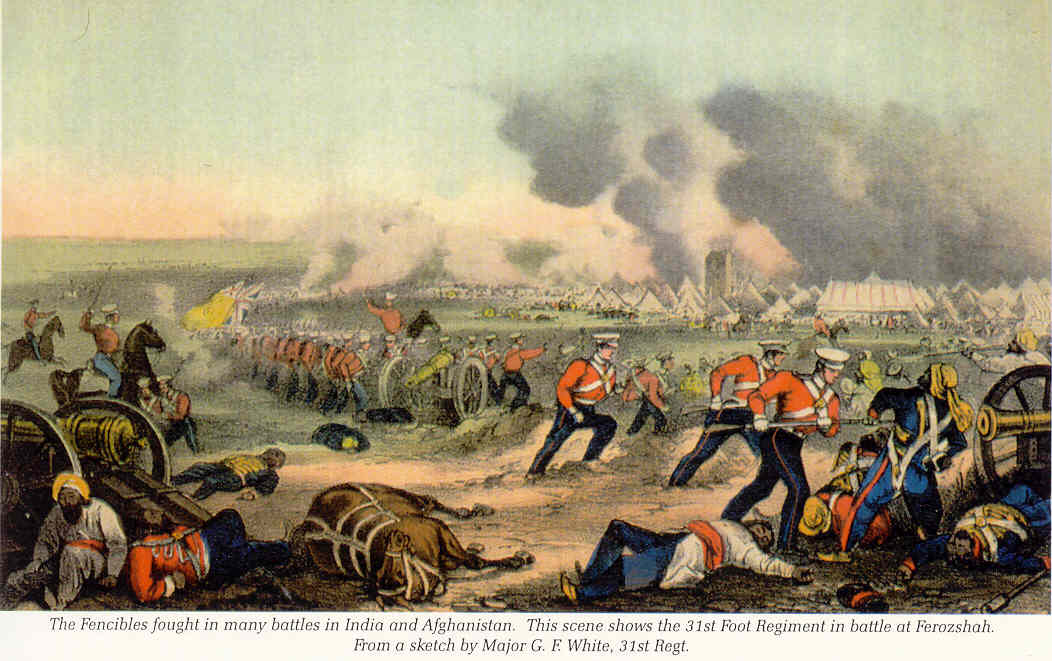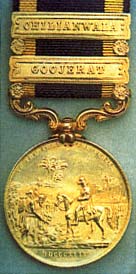Punjab Campaign
Medal
7th September 1848 to 14th March 1849

This campaign was
virtually a continuation of the Sutlej War which had left the militant Sikhs in a state
of unrest. The Punjab flared into rebellion in 1848 and e British
fielded two armies; one 28,000 strong under Major  General
Whish besieged the stronghold of Mooltan whilst the second, under Lord
Gough, turned northwards towards the Punjab. On 13th January Gough reached
Chilianwala where a Sikh army under Sher Singh was entrenched. In the
savage battle that followed, where both sides slaughtered the enemy
wounded, the British lost several colours, four guns and over 15 per cent
of heir effective strength. Heaviest casualties were suffered by the
South
Wales Borderers who lost
21 officers and 503 other ranks killed or wounded. Both sides withdrew to
their respective camps where they were bogged down by three days of
torrential rain. However, on 22nd January, Mooltan had been stormed and
Whish's troops moved northward to support Gough. Shere
Singh struck his camp and moved
eastward making for Lahore but on 20th February the combined British forces,
totalling 24,000 men and 96 guns caught up with the Sikhs at Goojerat. The
battle started at 7am and by early afternoon the enemy were in full
retreat, abandoning their guns, wounded and
baggage.
General
Whish besieged the stronghold of Mooltan whilst the second, under Lord
Gough, turned northwards towards the Punjab. On 13th January Gough reached
Chilianwala where a Sikh army under Sher Singh was entrenched. In the
savage battle that followed, where both sides slaughtered the enemy
wounded, the British lost several colours, four guns and over 15 per cent
of heir effective strength. Heaviest casualties were suffered by the
South
Wales Borderers who lost
21 officers and 503 other ranks killed or wounded. Both sides withdrew to
their respective camps where they were bogged down by three days of
torrential rain. However, on 22nd January, Mooltan had been stormed and
Whish's troops moved northward to support Gough. Shere
Singh struck his camp and moved
eastward making for Lahore but on 20th February the combined British forces,
totalling 24,000 men and 96 guns caught up with the Sikhs at Goojerat. The
battle started at 7am and by early afternoon the enemy were in full
retreat, abandoning their guns, wounded and
baggage.
A General Order dated 2nd April
1849 granted a medal to
all forces employed in the Punjab during the campaign. The reverse of this medal is
extremely detailed and shows he Sikh army surrendering their arms and
colours in front of a mounted officer. Two regiments of
East
India troops, complete
with colours, are drawn up in the middle distance, whilst in the
background there are large palm trees on a hill. Around the top is the
legend TO THE ARMY OF THE PUNJAB, and in the exergue the date in Roman numerals
MDCCCXLIX. The obverse carries the diademed head of Queen
Victoria and the ribbon is dark blue with a yellow stripe
on each side, threaded through an ornamental swivelling suspender. Three
clasps were issued for the main actions - MOOLTAN, for those engaged in he
siege from 7th September 1848 until 22 January
1849 and CHILIANWALA and
GOOJERAT for the two main battles. The maximum number of clasps to any one
man was two, although there are numerous medals without clasps awarded to
troops who did not participate in any of the three main actions. Naming is
in impressed Roman capitals.
http://www.britishbattles.com/second-sikh-war/ramnagar.htm 






